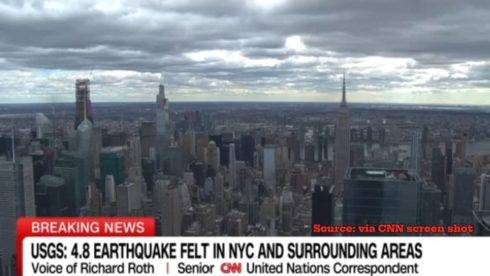Earthquake strikes the residents of New York and the surrounding Tri-State Area experience an unexpected phenomena. According to reports from the U.S. Geological Survey, the earthquake, initially measured at 4.8 magnitude, sent tremors rippling through the region. The occurrence of earthquakes in this area is relatively rare, adding to the surprise and concern among locals.
Authorities are currently assessing the situation to determine any damage or potential risks posed by the earthquake. While initial reports suggest no significant damage or injuries, residents are advised to remain vigilant and follow safety protocols. Earthquakes of this magnitude can sometimes result in structural damage to buildings and infrastructure, underscoring the importance of preparedness and response measures.
Earthquake Strikes: Response and Preparedness Measures
Following the earthquake strikes, emergency response teams sprang into action to ensure the safety and well-being of residents in the affected areas. Local authorities have activated response protocols, including conducting rapid assessments of critical infrastructure such as bridges, tunnels, and utility lines. Additionally, emergency shelters have been set up to accommodate individuals displaced by the earthquake.
In light of the seismic activity, residents are urged to review and update their emergency preparedness plans. This includes securing heavy objects that could become projectiles during an earthquake, identifying safe locations within homes or workplaces, and preparing emergency supply kits. Heightened awareness and preparedness can significantly mitigate the impact of natural disasters like earthquakes, reinforcing the importance of community resilience.
Earthquake Strikes: Impact on Transportation and Infrastructure
The earthquake strikes has prompted concerns regarding its impact on transportation networks and critical infrastructure throughout the Tri-State Area. Reports indicate temporary disruptions to public transit services as authorities conduct safety inspections of tracks and stations. Additionally, road closures may be implemented to assess and address any damage to bridges and overpasses.
Efforts are underway to swiftly restore normalcy to transportation systems while prioritizing public safety. Engineers and inspectors are assessing the structural integrity of key infrastructure elements to determine the extent of any damage caused by the earthquake. Timely repairs and maintenance will be crucial to minimizing disruptions and ensuring the continued functionality of essential services.
Earthquake Strikes: Reactions from Residents and Witnesses
In the aftermath of the earthquake, residents and witnesses have been sharing their experiences and reactions to the unexpected seismic event. Social media platforms are abuzz with accounts of the tremors felt across neighborhoods, with many expressing surprise at the rare occurrence in the region. Some individuals have reported minor property damage, such as fallen objects or cracked walls, highlighting the immediate impact of the earthquake.
Others have praised the swift response of emergency services and the solidarity displayed by communities in times of crisis. Despite the initial shock, there is a sense of resilience and determination among residents to overcome any challenges posed by the earthquake. This collective spirit serves as a reminder of the strength and resilience of the Tri-State Area in the face of adversity.
Earthquake Strikes: Historical Context and Seismic Activity
While earthquakes are relatively uncommon in the Tri-State Area compared to other regions, they are not unprecedented. The geological history of the area reveals occasional seismic activity, albeit on a smaller scale. The occurrence of earthquakes is attributed to the complex tectonic processes underlying the region, including the interaction of various fault lines.
Seismologists and geologists will analyze data from this earthquake to gain insights into regional seismic activity and potential future risks. Understanding the geological characteristics of the area is essential for implementing effective mitigation strategies and building resilient communities prepared to face natural hazards.
Preparedness and Resilience Building for Earthquake Strikes
As the Tri-State Area recovers from the recent earthquake, attention turns to long-term preparedness and resilience-building efforts. Community leaders, emergency management agencies, and policymakers will collaborate to enhance disaster preparedness plans and infrastructure resilience. This includes investing in seismic retrofitting of buildings, improving early warning systems, and conducting public awareness campaigns.
The earthquake strikes serves as a wake-up call for residents and authorities to prioritize disaster preparedness as an integral part of urban planning and development. By working together and adopting proactive measures, the Tri-State Area can strengthen its resilience to future earthquakes and other natural disasters, ensuring the safety and well-being of its residents.
Table of Contents
Discover more from OGM News NG
Subscribe to get the latest posts sent to your email.














